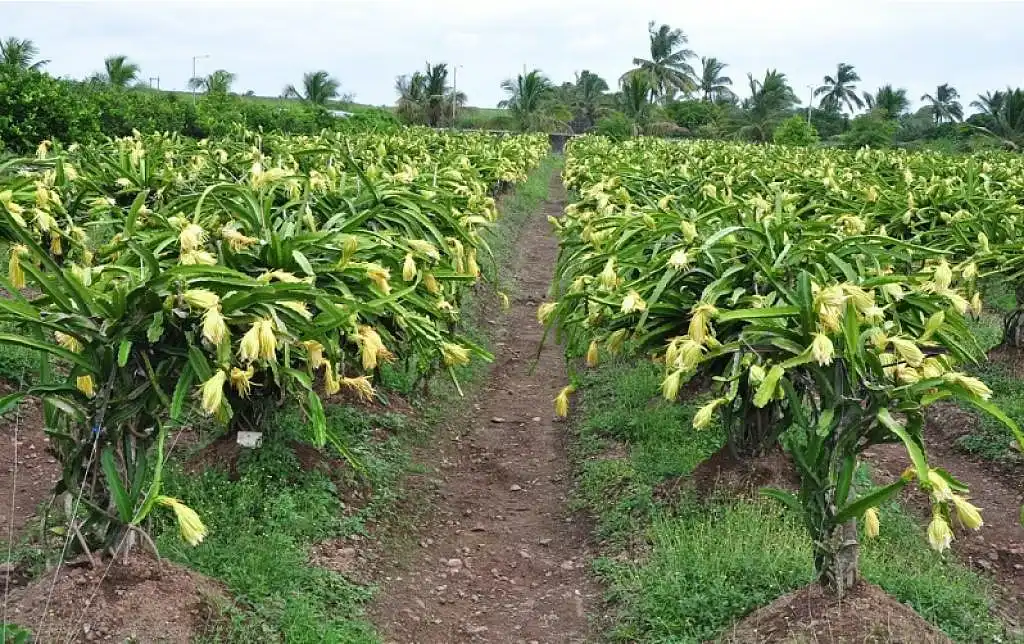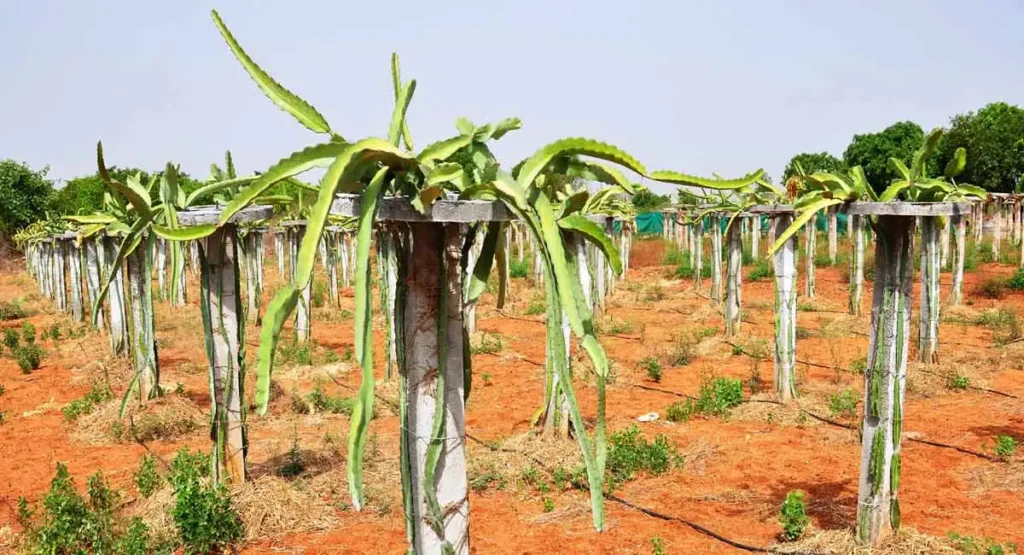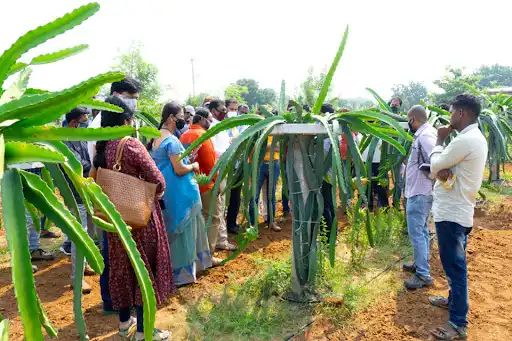Dragon fruit, also known as Pitaya, is a tropical fruit gaining popularity in India due to its health benefits, high market demand, and profitability. Originally from Central America, it thrives well in India’s warm climate, making it an excellent choice for farmers looking to diversify their crops. This guide covers everything you need to know about dragon fruit farming, including climate, soil preparation, planting, irrigation, pest management, harvesting, and marketing strategies.

1. Climate & Soil Requirements
Ideal Climate for Dragon Fruit Cultivation
- Best suited for tropical and subtropical climates.
- Temperature range: 10°C to 40°C.
- Requires moderate rainfall (500-1500 mm per year).
- Can tolerate drought, but prolonged exposure to extreme temperatures may affect fruiting.
Suitable Soil for Dragon Fruit Farming
- Well-drained sandy loam or loamy soil.
- pH level: 5.5 to 7.5.
- Avoid heavy clay and waterlogged soils.
- Organic matter-rich soil improves fruit quality and yield.
2. Best Dragon Fruit Varieties
Dragon fruit comes in different varieties based on color and taste:
Popular Varieties
- Hylocereus undatus – White flesh with pink skin (mild sweetness).
- Hylocereus costaricensis – Red flesh with pink skin (rich flavor).
- Hylocereus megalanthus – White flesh with yellow skin (sweetest variety).
Hybrid Varieties for High Yield
- Viet Red – Deep red flesh, high yield.
- American Beauty – Large fruit with bright pink skin.
- Thai White – Popular in India for its adaptability.
3. Land Preparation & Planting
Land Preparation
- Plow the field 2-3 times to remove weeds.
- Add organic compost or well-decomposed cow dung.
- Set up a support system (concrete or wooden posts) as dragon fruit plants are climbers.
Propagation Methods
- Seed propagation (rare, slow-growing, not preferred).
- Cutting propagation (most efficient, quick growth and early yield).
Planting Method
- Spacing: 2-3 meters apart.
- Plant Density: 600-800 plants per acre.
- Plant 30-50 cm long stem cuttings.
- Water immediately after planting to encourage root development.
Read More :-

4. Irrigation & Water Management
- Dragon fruit is a drought-tolerant crop, requiring minimal irrigation.
- Watering frequency:
- Summer: Every 7-10 days.
- Winter: Every 15-20 days.
- Drip irrigation is recommended for efficient water use and uniform moisture.
- Avoid overwatering, as it may cause root rot.
5. Fertilizer & Nutrient Management
Organic Fertilizers
- Compost/Vermicompost – Enhances soil fertility.
- Cow dung manure – Boosts microbial activity.
Chemical Fertilizers
- Nitrogen (N): 50 kg per hectare.
- Phosphorus (P): 40 kg per hectare.
- Potassium (K): 30 kg per hectare.
- Micronutrients (Zinc, Magnesium, Boron) – Enhances fruit size and sweetness.
6. Pest & Disease Management
Common Pests & Their Control
- Aphids & Mealybugs – Spray Neem oil or insecticidal soap.
- Fruit Flies – Use pheromone traps.
- Ants & Termites – Apply organic insecticides.
Major Diseases & Control Measures
- Stem Rot – Avoid overwatering and improve drainage.
- Anthracnose (Fungal Infection) – Use Copper Oxychloride spray.
- Bacterial Spot – Apply Bordeaux mixture.
7. Flowering, Pollination & Fruit Development
- Dragon fruit plants begin flowering within 8-12 months after planting.
- Flowers open at night and last for a single day.
- Hand pollination increases fruit set and yield.
- Fruits take 30-50 days to mature after pollination.
8. Harvesting & Yield
Harvesting Time
- Fruits are ready 30-50 days after flowering.
- Best harvesting period: June to November.
- Ideal fruit color: Bright red or yellow (depending on variety).
Yield Per Plant
- First Year: 3-5 kg per plant.
- Full Maturity (3-5 Years): 10-15 kg per plant.
- Expected Yield Per Acre: 5-6 tons.
9. Post-Harvest Management
Post-Harvest Handling
- Sorting & Grading: Based on size, color, and quality.
- Storage: Can be stored at 5-10°C for up to 4 weeks.
- Packaging: Use ventilated crates to prevent damage.
Value Addition for Higher Profits
- Dragon Fruit Juice
- Dragon Fruit Jam & Jelly
- Dried Dragon Fruit Chips
10. Marketing & Export Opportunities
Domestic Market
- Sold in wholesale markets, supermarkets, and fruit vendors.
- Used in restaurants, juice bars, and food processing industries.
Export Market
- Major importers: USA, Europe, UAE, China.
- Certification required: Global GAP, Organic Certification.
- Indian dragon fruit is gaining popularity in international markets.

11. Government Schemes & Subsidies
Financial Assistance for Dragon Fruit Farmers
- National Horticulture Board (NHB) – Subsidies for plantation and post-harvest infrastructure.
- PM-Kisan Yojana – ₹6,000 per year for farmers.
- Agriculture Infrastructure Fund – Loans for farm infrastructure development.
- Organic Farming Subsidies – Support for organic dragon fruit cultivation.
12. Conclusion
Dragon fruit farming is a highly profitable agribusiness with low maintenance requirements and high returns. With increasing demand in domestic and international markets, farmers can maximize profits through proper cultivation techniques, post-harvest processing, and strategic marketing.
Would you like to explore organic dragon fruit farming or export strategies for better profits? 🚜🐉🍉

